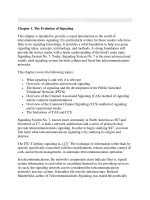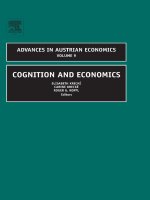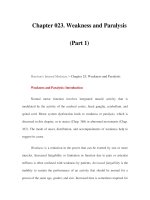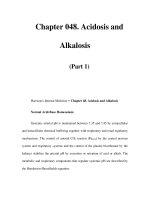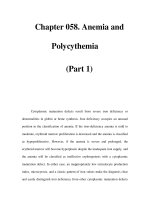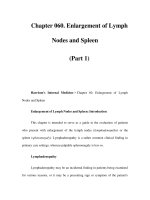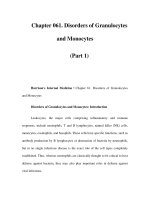Candida infections detection and epidemiology - part 1 pps
Bạn đang xem bản rút gọn của tài liệu. Xem và tải ngay bản đầy đủ của tài liệu tại đây (286.74 KB, 15 trang )
Candida infections
detection and epidemiology
Cover: 'budding sea-creature' by Ingrid C. Roos
photography: Annemarie Borst
Printed by: Ponsen & Looijen BV, Wageningen
ISBN: 90-393-3084-0
Candida infections
detection and epidemiology
Candida infecties
detectie en epidemiologie
(met een samenvatting in het Nederlands)
Proefschrift
ter verkrijging van de graad van doctor
aan de Universiteit Utrecht
op gezag van de Rector Magnificus
Prof. dr. W.H. Gispen
ingevolge het besluit van het College voor Promoties
in het openbaar te verdedigen
op vrijdag 6 september 2002 des middags te 12.45 uur
door
Annemarie Borst
geboren op 20 mei 1972 te Castricum
promotor: Prof. dr. J. Verhoef
co-promotor: Dr. A.C. Fluit
Het onderzoek beschreven in dit proefschrift werd mogelijk gemaakt door financiële steun
van bioMérieux, Boxtel, Nederland (voorheen Organon Teknika).
Het drukken van dit proefschrift werd mede mogelijk gemaakt door Applied Biosystems,
Wyeth Pharmaceuticals, Pfizer bv, MSD B.V. en ICN Pharmaceuticals Holland B.V.
here I stand by the mountain
look up to the sky
knowing it's a matter of having to climb
above this place these clouds lie
(Luka Bloom)
Contents
Introduction 5
I: Value of terminal subculture of automated blood cultures in patients
with candidaemia
Eur. J. Clin. Microbiol. Infect. Dis. (2000), 19: 803-805
17
II: Nucleic acid sequence-based amplification (NASBA) detection of
medically important Candida species
J. Microbiol. Methods (1999), 38: 81-90
21
III: Detection of Candida spp. in blood cultures using nucleic acid
sequence-based amplification (NASBA)
Diagn. Microbiol. Infect. Dis. (2001), 39: 155-160
35
IV: Clinical evaluation of a NASBA-based assay for detection of Candida
spp. in blood and blood cultures
Clin. Lab. (2002) In press
45
V: The Basic Kit amplification module for the detection of Candida spp.:
fungal RNA contamination of kit components
55
VI: False-positive results and contaminations in nucleic acid amplification
assays. Suggestions for a 'prevent and destroy'-strategy
Submitted for publication
61
VII: AFLP as an identification method for medically important Candida spp.,
including C. dubliniensis
Submitted for publication
79
VIII: High levels of hydrolytic enzymes secreted by Candida albicans isolates
involved in pneumonia
Submitted for publication
91
IX: AFLP typing of European Candida albicans isolates shows geographical
specificities
Submitted for publication
101
Discussion
111
Nederlandse samenvatting
119
Dankwoord
123
Curriculum Vitae
127
List of publications
129
Introduction
Introduction
6
O
BJECTIVES
Candida species are opportunistic fungal pathogens which cause severe infections in
immunocompromised patients. Due to the profound developments in medical care, the number
of immunocompromised patients has increased, and so has the number of life-threatening
Candida infections
1
. At present, Candida is the 4th most common bloodstream pathogen in
North America and ranks 8th in Europe
13,19
. High-risk groups include: neutropenic cancer
patients, bone marrow and organ transplant recipients, patients suffering from AIDS, diabetics,
and patients receiving broad-spectrum antibiotics or parenteral nutrition. Attributable mortality
of Candida infections is as high as 38%, and crude mortality rates exceed 50%
15,29,44,45
.
The most commonly used detection method for Candida infections, automated blood
culture, is inadequate. Many yeast infections remain undetected or are diagnosed only after
several days
25
. Furthermore, since different Candida species show differences in resistance
against antimycotic agents
13,28
, identification up to the species level is essential for adequate
treatment. In many clinical microbiological laboratories the identification methods are based
on phenotypic characteristics. However, some species show a high degree of phenotypic
similarity which complicates identification. Commercial tests usually show high sensitivities
and specificities for Candida albicans, but are less reliable or require further testing for the
identification of other species
3,6,12,17
.
In addition to the inadequate detection, relatively little is known about the epidemiology of
Candida infections. Typing of different strains of the same Candida species and linking these
strain types to data on the presence of virulence factors or resistance to antimycotic agents may
improve our understanding of the epidemiology of this yeast, and may help to identify genetic
markers for these traits. Several typing methods have been used for Candida species, but none
of them is considered the golden standard
4,11,30,32,33,38
.
The first objective of this thesis was to improve the diagnosis and identification of Candida
infections. The second objective was to study the epidemiology of C. albicans. In particular,
we investigated whether a relatively new typing method, Amplified Fragment Length
Polymorphism analysis (AFLP), is suitable for typing C. albicans. Furthermore, the
relationship between the type of infection, geographic origin, and the expression of virulence
factors by clinical C. albicans isolates was examined.
D
ETECTION OF CANDIDA INFECTIONS
Automated blood culture. Automated blood culture systems are routinely used as
diagnostic tool. Since our hospital makes use of the BacT/Alert monitoring system of
bioMérieux (formerly Organon Teknika, Boxtel, the Netherlands) we focus here on this
device. However, although the contents of the culture media as well as the exact method of
detection differs between the different systems, the basic protocol is the same. Blood is
inoculated directly into the culture bottles containing proprietary media based on enriched
trypticase soy broth. Different media are developed for the growth of aerobic and anaerobic
organisms. Furthermore, the development of 'FAN' bottles (fastidious antibiotic neutralization)
in some cases increased the detection rate
43
. Special media for detection of fungal growth are
Introduction
7
also available
14
. However, because it is labour intensive and expensive to use several systems
at the same time, most laboratories only use the standard blood culture bottles. In our hospital,
regular anaerobic bottles and FAN aerobic bottles are used.
The bottles are incubated under continuous agitation. A differentially permeable membrane
in the bottom of the bottle separates the medium from a pH sensor. This green colored sensor
turns yellow when carbon dioxide produced by growing microorganisms diffuses across the
membrane and reacts with water generating hydrogen ions. This lowering of the pH is
monitored by the instrument every ten minutes during incubation. When the instrument renders
a positive signal, further testing is needed to identify the organism grown in the bottle. Usually,
a Gram staining is performed, and the blood culture is subcultured on blood agar and, if
necessary, other media.
It is known that automated blood culture systems may fail to detect yeasts in up to 65% of
the cases
25
. Many blood culture media are not optimal for fungal growth. Also, growth of fungi
may be inhibited by the presence of antimycotic agents in the blood of the patient. The
question whether terminal subculture of negative blood culture bottles will lead to enhanced
detection rates is under debate
23,31,36,39,46
. In the study described in Chapter 1 of this thesis, we
examined whether terminal subculture of negative blood culture bottles improves the detection
rate for patients who are at high risk for candidaemia.
NASBA. Since automated blood culture systems often need several days before fungal
infections are detected, or even miss these infections entirely, improved detection methods are
needed. Nucleic acid amplification technologies provide promising tools for the rapid
detection of Candida species in clinical materials. Polymerase Chain Reaction (PCR) is the
most generally used amplification technique. However, in 1991 Compton described a new
amplification method, Nucleic Acid Sequence-Based Amplification (NASBA™), which has
several advantages over PCR
7
. A schematic representation of this technique is depicted in
Figure 1. The technique is based on the incorporation of a T7 RNA polymerase promotor
sequence in one of the primers. This primer anneals to the single stranded RNA target. After
primer extension by Avian Myeloblastosis Virus Reverse Transcriptase (AMV-RT), the RNA
strand of the resulting RNA/DNA hybrid is degraded by RNase H. The second primer anneals
to the single stranded cDNA, and a double stranded cDNA molecule is generated by AMV-RT.
This cDNA now contains a double stranded T7 promotor which enables T7 RNA polymerase
to generate multiple anti-sense RNA copies. These amplicons serve as templates for the cyclic
phase of the amplification, as shown on the right-hand side in Figure 1.
In contrast with PCR, NASBA is an isothermal process which eliminates the need for
(expensive) thermal cyclers. By using RNA as target, which is far less stable than DNA, the
risk of obtaining false-positive results due to amplification of nucleic acids from dead or
degrading cells is reduced. Also, no separate RT step is required for RNA amplification, and
RNA can be amplified in a background of DNA molecules. Furthermore, unlike PCR where
the initial primer level limits the maximum yield, the T7 RNA polymerase reuses the cDNA,
resulting in an exponential increase in RNA amplicons. In addition, these single stranded
amplicons are ideal targets for detection with specific probes, without the need for
denaturation. The NASBA assay developed in this thesis uses ribosomal RNA as target, which
can be present in as many as 10,000 copies per cell. This results in a very sensitive assay. The
characteristics and applications of NASBA have recently been reviewed by Deiman et al.
10
.
Introduction
8
Figure 1
Schematic representation of nucleic acid sequence-based amplification (NASBA)
In Chapter 2 of this thesis we describe the development of a NASBA assay for the
detection of Candida species. The primers are based on the conserved regions of the 18S
rRNA sequence of medically important fungi. Furthermore, specific probes were designed and
tested for the identification of the different medically important species, including C. glabrata
and C. krusei. Sample preparation remains a crucial step in all amplification methods. In case
of disseminated infections, it is favorable to use whole blood instead of plasma or serum. The
use of whole blood prevents the loss of target due to phagocytosed fungal cells or cells
attached to leukocytes or other blood cells. According to Jordan, the use of plasma resulted in
a loss of more than 50% of the initial input of C. albicans
21
. Rapid whole blood sample
preparation methods generally cannot process more than 200 µl blood
21,40
. In Chapter 2 an
improved rapid sample preparation for whole blood samples up to 1 ml is described.
Amplification technologies can also be used to reduce the time needed for species
identification after growth is detected in blood culture bottles. Besides detection of Candida
species directly in blood samples of patients, we wanted to know whether we could use our
NASBA assay to quicken and maybe even improve the detection rate of Candida species in
blood cultures. Therefore, culture-positive as well as negative blood cultures from patients
with a proven candidaemia were analyzed, and the results of the NASBA assay were compared
with the results of BacT/Alert monitoring. The results of this study are described in Chapter 3.
After the encouraging results of the previous studies, a clinical trial was initiated in order to
evaluate the use of the NASBA assay for the improved detection of Candida species in
patients suspected of having candidaemia. Since candidaemia is characterized by a low number
of yeast cells in the blood stream, testing of blood culture samples after a short (2 day) culture
step was also included. The results of this clinical trial are presented in Chapter 4.
Contamination control. Implementation of the NASBA assay in a routine clinical
p
rimer 1
R
everse
T
ranscriptase
R
Nase H
p
rimer 2
R
everse
T
ranscriptase
sense RNA
primer 2
RNase H
primer 1
anti-sense RNA
T7 RNA polymerase
Reverse Transcriptase
Reverse Transcriptase
Introduction
9
laboratory requires considerable standardization of the different procedures. In Chapters 3 and
4, our amplicon detection assay was successfully replaced by the NucliSens Basic Kit
detection module in combination with the NucliSens reader (bioMérieux (formerly Organon
Teknika), Boxtel, the Netherlands). Chapter 5 describes our efforts to replace our in-house
NASBA amplification protocol by the NucliSens Basic Kit amplification module.
Unfortunately, impracticable difficulties with false-positive results were encountered due to
contaminated components of the kit, and it was decided to continue working with our in-house
assay. Over the years, working with sensitive amplification technologies like NASBA has
inevitably experienced us in contamination control. The current problems lead us to review the
implications of contaminations in diagnosis and research on infectious diseases (Chapter 6).
In the same review we also discuss the functionality and draw-backs of different methods for
prevention and destruction of contaminating DNA and give recommendations on how to
improve laboratory practice.
Figure 2
Schematic representation of amplified fragment length polymorphism analysis (AFLP)
•
adapter ligation
•
EcoRI + MseI
m
m
m
m
m
m
e
e
e
e
e
e
•
amplification
•
denaturation
•
primer annealing
Introduction
10
AFLP. While Candida albicans used to be the main cause of invasive fungal infections,
non-albicans Candida species like C. glabrata, C. krusei and C. parapsilosis are increasingly
isolated. These non-albicans Candida species now account for approximately 50% of all
Candida infections
22
. The different Candida species show differences in resistance to
antimycotic agents. C. krusei is innately resistant to fluconazole, and C. glabrata is able to
acquire resistance to this drug very rapidly
13,28
. Furthermore, C. glabrata infections have been
associated with an extremely high mortality
16
. Therefore, to start an adequate treatment as
early as possible, it is essential to rapidly detect the causative organism up to the species level.
With the NASBA assay developed in this thesis, it is possible to identify most medically
important Candida species. Other probes can be designed and implemented in the assay when
more species need to be identified. However, Amplified Fragment Length Polymorphism
analysis (AFLP
41
), may also prove to be an excellent identification tool.
A schematic representation of AFLP is shown in Figure 2. Chromosomal DNA is digested
with two restriction enzymes, e.g. EcoRI and MseI, and adapters are ligated to the fragments.
These adapters are known sequences which are designed in such a way that after ligation the
recognition sites for the restriction enzymes are lost. Hence, restriction and ligation can take
place in the same reaction tube. Two types of fragments are formed: fragments with the same
adapter at both ends and fragments with the two different adapters at each end. The adapters
are used as targets for the primers during PCR amplification. However, fragments with the
same adapter at both ends will generally form 'stem-loop' structures after denaturation, which
makes it impossible for the primers to anneal. Therefore, the amplification products will
contain mainly fragments with a different adapter at each end. If necessary, by using one or
more selective nucleotides on the 3'-end of the primers, the number of amplified fragments can
be reduced to obtain a more distinctive pattern. One of the primers is labeled with a fluorescent
dye. The fragments are separated in an automated sequence apparatus, and analyzed using
software packages like BioNumerics (Applied Maths, Sint-Martens-Latem, Belgium).
The advantages and disadvantages of AFLP and the NASBA assay are summarized in Table
1. Both methods only need small amounts of starting material and can be obtained in a kit
format. The advantage of the NASBA assay over AFLP is that the former can be applied
directly on clinical material, which speeds up the whole process. AFLP on the other hand is
universally applicable and by storing the patterns, including those of reference strains, in a
general accessible database a screening library for identification of species is obtained.
Furthermore, for numerous organisms AFLP patterns can also be used for strain typing
35
. In
conclusion: the NASBA assay is preferable for rapid diagnosis, whereas AFLP may be helpful
to identify unknown isolates from cultures. Chapter 7 of this thesis describes the use of AFLP
as an identification method for medically important Candida species.
EPIDEMIOLOGY OF CANDIDA INFECTIONS
Virulence. Several putative virulence factors of C. albicans have been described
5
. One
remarkable virulence factor is the capacity of C. albicans to 'switch' between different
phenotypes at a relatively high frequency. This switching is characterized by differences in
colony morphology, e.g. 'white', 'opaque', 'star', 'stippled', 'hat', 'irregular', 'wrinkle', and 'fuzzy'.
Introduction
11
Table 1
Advantages and disadvantages for the NASBA assay and AFLP as identification methods
Advantages Disadvantages
NASBA assay - directly on clinical material
- small amounts of material are sufficient
- rapid
- standardization with kit
- several species-specific probes needed
- not every species identifiable in current
assay
AFLP - universally applicable
- database screening of results
- possibilities for strain typing
- small amounts of material are sufficient
- standardization with kit
- pure sample necessary
- less rapid
Phenotypic switching is reversible and is accompanied by changes in antigen expression and
tissue affinities. Furthermore, transition between unicellular yeast cells and filamentous growth
forms occurs. The formation of (pseudo)hyphae is probably associated with an enhanced
capability to invade host tissues. C. albicans also produces adhesins, biomolecules that
promote the adherence of the yeast to host cells. In addition, the organism secretes hydrolytic
enzymes such as phospholipases and secreted aspartyl proteinases. Phospholipases most likely
contribute to the pathogenicity of C. albicans by damaging host cell membranes, aiding the
fungus by invasion of host tissues
24
. Secreted aspartyl proteinases are capable of degrading
epithelial and mucosal barrier proteins like collagen, keratin and mucin, as well as antibodies,
complement and cytokines
9
.
The importance of these enzymes in C. albicans virulence has been ascertained by cloning
and disrupting the genes involved, and studying the effect of these mutations on the virulence
in animal models. Disruption of the phospholipase B gene significantly attenuated virulence in
mice and dramatically reduced the ability of the yeast to penetrate host cells
24
. Disruption of
the genes involved in secreted aspartyl proteinase production resulted in altered adherence of
yeast cells and attenuation of virulence in different animal models
8,18,34,42
.
The expression of certain virulence factors may be associated with specific characteristics
such as geographic origin of the isolates or the type of infection. Knowledge of such
correlations may help to understand the epidemiology of these infections. This may result in
improved therapeutic regimens. In Chapter 8, the differences in phospholipase and secreted
aspartyl proteinase production of a large panel of clinical C. albicans isolates obtained from 12
different European countries were studied, and the results were linked to data on the
geographic origin of the isolates and the site of infection.
Strain typing. Strain typing is important in various situations
37
. When an outbreak of
disease occurs in a hospital (ward), strain typing can be used to investigate whether this
outbreak is caused by a single strain, or whether several strains are involved. Furthermore, by
testing isolates from patients, health care workers and the hospital environment the origin of
the outbreak can be identified and adequate measures to stop the outbreak and prevent future
recurrences can be undertaken. Strain typing can also be of use to unravel the relationship
between commensal and pathogenic strains. It is generally acknowledged that most infecting
Introduction
12
Candida strains originate from the host's commensal flora. However, are all commensals
capable of becoming pathogens? Strain typing methods have proven to be valuable tools in
research on strain persistence or replacement during different stages of infections. Besides the
dynamics of yeast strains within in human being, it is also essential to understand the dynamics
of the organism in a human population. Are certain strains or clusters of strains associated with
a geographic locale? Are there endemic strains in particular hospital wards?
Besides being a tool for the identification of different species, AFLP may also be suitable
for typing C. albicans. In fact, AFLP was developed as a typing method, and has been used
successfully for many organisms including Saccharomyces cerevisiae, a close relative of C.
albicans
2,35,41
. Several other typing methods have been described for C. albicans. However, no
method has been accepted as the golden standard. Randomly Amplified Polymorphic DNA
analysis (RAPD) has the disadvantage of being less reproducible than AFLP
20,35
. Other
fingerprinting techniques which are often used are based on selective parts of the genome. For
example, the PCR fingerprinting method described by Meyer et al. uses mini- and
microsatellite sequences as targets for the primers
27
, reference strand-mediated conformational
analysis (RSCA) is based on 18S rRNA sequences
26
, and the Ca3 probe used in Southern blot
hybridizations of EcoRI digested genomic DNA hybridizes with genomic sequences
containing repetitive elements
33
. AFLP patterns are a representation of the whole genome.
Furthermore, these patterns can easily be stored in (general accessible) databases, which
greatly facilitates the exchange of results between laboratories. In Chapter 9 of this thesis we
investigated whether AFLP is suitable for typing C. albicans. AFLP was used to type the
collection of European clinical C. albicans isolates, and the correlation between AFLP type
and geographical origin, site of infection and the production of hydrolytic enzymes was
studied.
The results of all studies described in this thesis will provide tools for the improvement of
diagnosis and identification of Candida infections, and contribute to our understanding of the
epidemiology of this yeast.
R
EFERENCES
1. Abi Said, D., E. Anaissie, O. Uzun, I. Raad, H. Pinzcowski, and S. Vartivarian. 1997. The epidemiology
of hematogenous candidiasis caused by different Candida species. Clin. Infect. Dis. 24: 1122-1128
2. Azumi, M. and N. Goto-Yamamoto. 2001. AFLP analysis of type strains and laboratory and industrial
strains of Saccharomyces sensu stricto and its application to phenetic clustering. Yeast 18: 1145-1154
3. Bernal, S., M.E. Martin, M. Chavez, J. Coronilla, and A. Valverde. 1998. Evaluation of the new API
Candida system for identification of the most clinically important yeast species. Diagn. Microbiol. Infect.
Dis. 32: 217-221
4. Boerlin, P., F. Boerlin-Petzold, J. Goudet, C. Durussel, J.L. Pagani, J.P. Chave, and J. Bille. 1996.
Typing Candida albicans oral isolates from human immunodeficiency virus-infected patients by multilocus
enzyme electrophoresis and DNA fingerprinting. J. Clin. Microbiol. 34: 1235-1248
Introduction
13
5. Calderone, R.A. and W.A. Fonzi. 2001. Virulence factors of Candida albicans. Trends Microbiol. 9: 327-
335
6. Campbell, C.K., K.G. Davey, A.D. Holmes, A. Szekely, and D.W. Warnock. 1999. Comparison of the
API Candida system with the AUXACOLOR system for identification of common yeast pathogens. J. Clin.
Microbiol. 37: 821-823
7. Compton, J. 1991. Nucleic acid sequence-based amplification. Nature 350: 91-92
8. De Bernardis, F., S. Arancia, L. Morelli, B. Hube, D. Sanglard, W. Schafer, and A. Cassone. 1999.
Evidence that members of the secretory aspartyl proteinase gene family, in particular SAP2, are virulence
factors for Candida vaginitis. J. Infect. Dis. 179: 201-208
9. De Bernardis, F., P.A. Sullivan, and A. Cassone. 2001. Aspartyl proteinases of Candida albicans and their
role in pathogenicity. Med. Mycol. 39: 303-313
10. Deiman, B., P. Van Aerle, and P. Sillekens. 2002. Characteristics and applications of nucleic acid
sequence-based amplification (NASBA). Mol. Biotechnol. 20: 163-179
11. Diaz-Guerra, T.M., J.V. Martinez-Suarez, F. Laguna, and J.L. Rodriguez-Tudela. 1997. Comparison of
four molecular typing methods for evaluating genetic diversity among Candida albicans isolates from human
immunodeficiency virus-positive patients with oral candidiasis. J. Clin. Microbiol. 35: 856-861
12. Espinel-Ingroff, A., L. Stockman, G. Roberts, D. Pincus, J. Pollack, and J. Marler. 1998. Comparison of
RapID yeast plus system with API 20C system for identification of common, new, and emerging yeast
pathogens. J. Clin. Microbiol. 36: 883-886
13. Fluit, A.C., M.E. Jones, F.J. Schmitz, J. Acar, R. Gupta, and J. Verhoef. 2000. Antimicrobial
susceptibility and frequency of occurrence of clinical blood isolates in Europe from the SENTRY
antimicrobial surveillance program, 1997 and 1998. Clin. Infect. Dis. 30: 454-460
14. Fricker Hidalgo, H., F. Chazot, B. Lebeau, H. Pelloux, P. Ambroise Thomas, and R. Grillot. 1998. Use
of simulated blood cultures to compare a specific fungal medium with a standard microorganism medium for
yeast detection. Eur. J. Clin. Microbiol. Infect. Dis. 17: 113-116
15. Giamarellou, H. and A. Antoniadou. 1996. Epidemiology, diagnosis, and therapy of fungal infections in
surgery. Infect. Control Hosp. Epidemiol. 17: 558-564
16. Gumbo, T., C.M. Isada, G. Hall, M.T. Karafa, and S.M. Gordon. 1999. Candida glabrata Fungemia.
Clinical features of 139 patients. Medicine 78: 220-227
17. Hoppe, J.E. and P. Frey. 1999. Evaluation of six commercial tests and the germ-tube test for presumptive
identification of Candida albicans. Eur. J. Clin. Microbiol. Infect. Dis. 18: 188-191
18. Hube, B., D. Sanglard, F.C. Odds, D. Hess, M. Monod, W. Schafer, A.J. Brown, and N.A. Gow. 1997.
Disruption of each of the secreted aspartyl proteinase genes SAP1, SAP2, and SAP3 of Candida albicans
attenuates virulence. Infect. Immun. 65: 3529-3538
19. Jarvis, W.R. 1995. Epidemiology of nosocomial fungal infections, with emphasis on Candida species. Clin.
Infect. Dis. 20: 1526-1530
20. Jones, C.J., K.J. Edwards, S. Castaglione, M.O. Winfield, F. Sala, C. VandeWiel, G. Bredemeijer, B.
Vosman, M. Matthes, A. Daly, R. Brettschneider, P. Bettini, M. Buiatti, E. Maestri, A. Malcevschi, N.
Marmiroli, R. Aert, G. Volckaert, J. Rueda, R. Linacero, A. Vazquez, and A. Karp. 1997.
Reproducibility testing of RAPD, AFLP and SSR markers in plants by a network of European laboratories.
Molecular Breeding 3: 381-390
21. Jordan, J.A. 1994. PCR identification of four medically important Candida species by using a single primer
pair. J. Clin. Microbiol. 32: 2962-2967
22. Kao, A.S., M.E. Brandt, W.R. Pruitt, L.A. Conn, B.A. Perkins, D.S. Stephens, W.S. Baughman, A.L.
